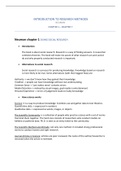INTRODUCTION TO RESEARCH METHODS
NEUMAN
CHAPTER 1 – CHAPTER 7
Neuman chapter 1 DOING SOCIAL RESEARCH
• Introduction
The book is about social research. Research is a way of finding answers. A researcher
combines theories. The book will make me aware of what research can and cannot
do and why properly conducted research is important.
• Alternatives to social research
Social research is a process for producing knowledge. Knowledge based on research
is more likely to be true. Some alternatives (with their biggest flaw) are:
Authority -> we don’t know how they gained their knowledge
Tradition -> people can have knowledge without real understanding
Common Sense -> ‘just makes sense’ contains errors
Media Distortion -> mislead by visual images, goal media is entertainment
Personal Experience -> errors of judgement leads to faulty knowledge
• How science works
Science: it is a way to produce knowledge. Scientists use and gather data to test theories.
Quantitative data -> expressed in numbers
Qualitative data -> expressed as words, images, or objects
The Scientific Community: is a collection of people who practice science with a set of norms
that bind them together. The hard core consists of researchers who conduct studies on
fulltime or parttime base. Ph.D. is seen as an entry ticket to the community.
The Scientific Method and Attitude: not only one method. It included strong professional
norms to conduct honest and right research.
Journal Articles in Science: articles are peer reviewed, the name of the author/researcher is
removed when the article is reviewed.
, • Steps in the research process
• Dimensions of research
Researchers need to understand the advantages and disadvantages of every type of
research. There are 4 dimensions which distinct the different types:
Use of Research: How will you use study results?
There are two primary uses of study findings. One use is to advance understanding of the
fundamental nature of social life and knowledge over the long term. A second use is to apply study
results to solve specific, immediate problems or issues. There are different types of research:
Basic research advances fundamental knowledge about the social world.
Applied research is designed to address a specific concern or to offer solutions to a problem
identified by an employer, organisation etc. Scientific community is primary consumer of basic
research.
,Types of applied research:
Evaluation is applied research designed to find out whether a program, a new way of doing
something, a marketing campaign, a policy, and so forth, is effective—in other words, “Does it
work?” Often used in bureaucratic organizations. Limitations: research reports rarely go through a
rigorous peer review process, data are infrequently publicly available for others to inspect or learn
from, and the focus is often very narrow and fails to examine the full process by which a program
affects people’s lives. In addition, decision makers may selectively use to suit their purposes or
ignore evaluation findings with which they disagree.
Action is applied research that treats knowledge as a form of power.
Five characteristics:
1. You actively involve research participants in the research process (e. g., study design, data
collection).
2. You incorporate the everyday experiences and knowledge of ordinary people into the study.
3. You examine issues of exploitation, oppression, power, or inequality in the study.
4. You seek to raise consciousness and increase awareness of issues with the study.
5. You directly link the study to a plan or program of social–political action.
Most action researchers are explicitly political, not value neutral. Most action researchers also
believe that knowledge develops from direct experience, particularly the experience of engaging in
social political action.
Social impact assessment you estimate the likely consequences of a planned intervention or
intentional change to occur in the future.
Purpose of a Study: What is the primary purpose of your study?
, Exploration: ‘What?’ question
Description: ‘How’ and ‘Who’ question.
Explanation: ‘Why’ are things the way they are?
Time Dimension in Research: How will you incorporate time into the study?






